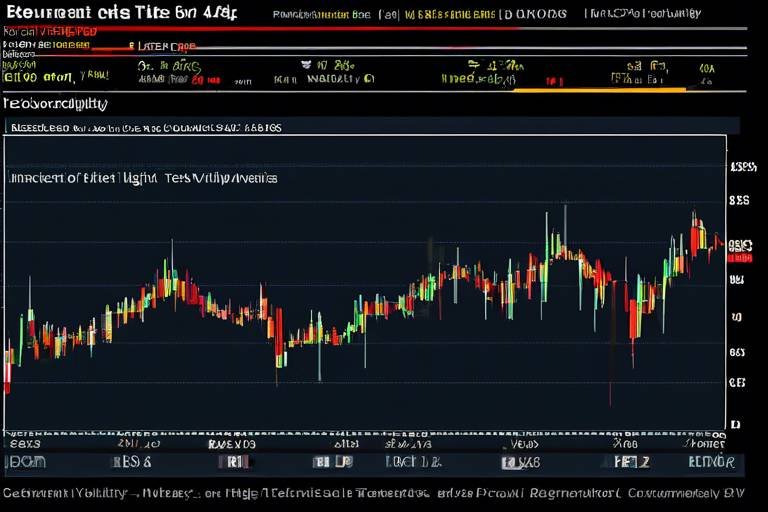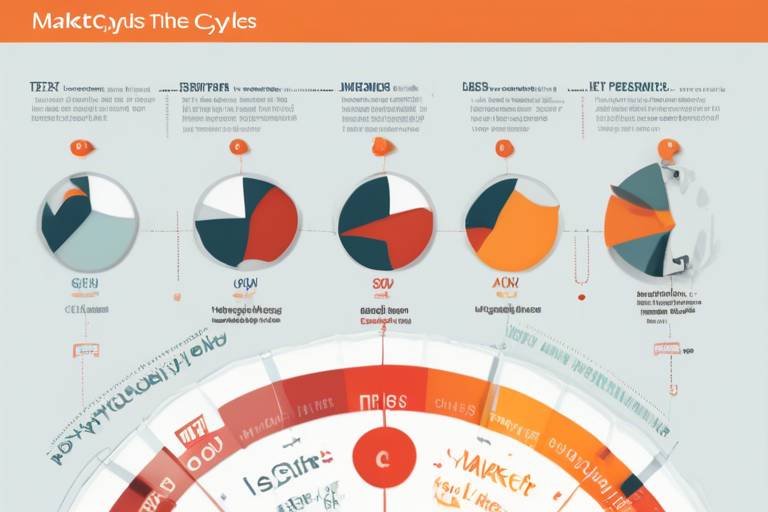The Importance of Trend Following in Cryptocurrency Markets
In the fast-paced world of cryptocurrency trading, trend following has emerged as a vital strategy for investors looking to navigate the unpredictable waters of digital assets. With prices swinging wildly from one moment to the next, it can feel like trying to catch smoke with your bare hands. However, by understanding and applying trend following techniques, traders can harness the power of momentum to potentially maximize their profits.
At its core, trend following is about identifying and capitalizing on the movements of asset prices. Think of it like surfing; you want to catch the wave at just the right moment to ride it all the way to the shore. In cryptocurrency markets, where volatility reigns supreme, this approach allows traders to align their actions with the market's direction, rather than fighting against it. But why is this strategy so important in the context of cryptocurrencies?
One of the primary reasons is the sheer volatility of these markets. Unlike traditional stocks or bonds, cryptocurrencies can experience massive price changes in a matter of hours or even minutes. This unpredictability can be daunting, but trend following provides a framework for making sense of these rapid shifts. By focusing on the prevailing trends, traders can make informed decisions that enhance their chances of success.
Moreover, trend following helps to reduce the psychological burden that often accompanies trading. Many traders fall victim to their emotions, making impulsive decisions that can lead to significant losses. By adhering to a trend following strategy, traders can maintain a level of discipline, allowing them to stick to their plans and avoid the emotional rollercoaster that can derail their investment strategies.
In summary, the importance of trend following in the cryptocurrency markets cannot be overstated. It equips traders with the tools to navigate volatility, helps in making informed decisions, and fosters a disciplined approach to trading. As we delve deeper into this article, we will explore the mechanics of trend following, its benefits, risks, and essential tools that can enhance your trading experience in the thrilling world of cryptocurrencies.
- What is trend following? Trend following is a trading strategy that aims to capitalize on the momentum of asset price movements by identifying and following the prevailing trends.
- Why is trend following important in cryptocurrency trading? Due to the high volatility of cryptocurrencies, trend following helps traders make informed decisions and reduces emotional trading.
- What are some common mistakes in trend following? Traders often misinterpret trends, fail to set stop-loss orders, or become overly emotional, which can lead to losses.
- What tools can assist with trend analysis? Popular tools include technical indicators like moving averages, Relative Strength Index (RSI), and various chart patterns.

Understanding Trend Following
Trend following is a trading strategy that has gained immense popularity, especially in the dynamic world of cryptocurrency. At its core, this strategy revolves around the idea of capitalizing on the momentum of price movements. Imagine surfing: you wouldn't paddle against the waves; instead, you would ride them to shore. In the same way, trend following allows traders to align themselves with the prevailing market direction, whether it’s a bullish or bearish trend.
The fundamental principle of trend following is relatively straightforward: if an asset is moving upward, you buy; if it’s moving downward, you sell. This approach relies heavily on the notion that trends tend to persist over time. In the cryptocurrency market, where volatility is the norm, recognizing and acting on these trends can lead to significant profits. However, it's essential to understand that trend following isn't just about blindly following the price movements; it requires a keen analytical eye to identify the right trends at the right time.
To effectively implement trend following, traders often utilize a variety of tools and indicators that help them gauge market momentum. These tools can include:
- Moving Averages: These smooth out price data to identify trends over a specific period.
- Relative Strength Index (RSI): This measures the speed and change of price movements to identify overbought or oversold conditions.
- Bollinger Bands: These help traders understand volatility and potential price reversals.
Understanding trend following also involves recognizing the different types of trends. There are three main categories:
- Uptrends: Characterized by higher highs and higher lows, indicating a bullish market.
- Downtrends: Defined by lower highs and lower lows, signaling a bearish market.
- Sideways Trends: Occur when prices move within a range, lacking a clear direction.
In the fast-paced cryptocurrency market, where emotions can run high, trend following provides a systematic approach that helps traders avoid impulsive decisions. By adhering to the trend, traders can minimize the impact of their emotions on their trading strategies. This is crucial, as emotional trading can lead to significant losses and missed opportunities.
In summary, understanding trend following is about more than just recognizing price movements; it's about developing a comprehensive strategy that incorporates market analysis, risk management, and emotional discipline. By embracing this approach, traders can navigate the unpredictable waters of cryptocurrency trading with greater confidence and potential for profitability.

Benefits of Trend Following
When it comes to navigating the unpredictable waters of cryptocurrency trading, trend following emerges as a beacon of hope for many traders. Imagine being able to ride the waves of market momentum instead of getting tossed around by the unpredictable currents. That's what trend following aims to achieve. One of the most significant advantages of this strategy is its potential for high returns. By identifying and capitalizing on established trends, traders can enter the market at just the right moment, maximizing their profits as prices climb. In the world of cryptocurrencies, where volatility can lead to dramatic price swings, this ability to align with the market can be incredibly lucrative.
Moreover, trend following helps to reduce emotional trading. Let's face it: trading can be an emotional rollercoaster. Fear and greed often dictate decisions, leading to impulsive actions that can derail even the best-laid plans. By adhering to a trend following strategy, traders can create a systematic approach that minimizes these emotional pitfalls. Instead of reacting to every market fluctuation, they can rely on data and established trends to guide their decisions, allowing for a more disciplined trading experience.
Another key benefit is the simplicity of the trend following approach. Unlike complex trading strategies that require extensive market knowledge and analysis, trend following can be straightforward. Traders can utilize basic indicators, such as moving averages or the Relative Strength Index (RSI), to identify trends without getting bogged down in intricate details. This makes it accessible for both novice and experienced traders alike. The ease of implementation means that even those new to the cryptocurrency space can start applying trend following techniques with relative comfort.
Additionally, trend following can be particularly effective in the cryptocurrency market due to its inherent volatility. Cryptocurrencies often experience rapid price changes, creating numerous opportunities for trend followers. By focusing on trends, traders can exploit these price movements to their advantage, potentially leading to significant profits. This is especially true in a market where traditional analysis methods may not always apply, and trends can shift dramatically in a matter of hours or days.
To summarize, the benefits of trend following in cryptocurrency trading are substantial. From the potential for high returns and reduced emotional trading to its simplicity and effectiveness in a volatile market, this strategy offers a compelling approach for traders looking to enhance their investment decisions. By aligning with market momentum and employing a disciplined strategy, traders can navigate the choppy waters of cryptocurrency trading with greater confidence.

Risk Management Strategies
When it comes to the wild world of cryptocurrency trading, **risk management** is your best friend. Think of it as your personal safety net, designed to catch you when the market throws you a curveball. In the unpredictable landscape of cryptocurrencies, where prices can soar to the moon one day and crash the next, having a solid risk management strategy is not just a luxury—it's a necessity. So, how do you effectively mitigate risks while trying to ride those profitable trends? Let’s dive into some strategies that can help you stay afloat.
First off, **position sizing** is crucial. This means determining how much of your capital you’re willing to risk on a single trade. A common rule of thumb is to risk no more than 1-2% of your total capital on any given trade. This way, even if a series of trades go south, you won’t wipe out your entire account. It’s like having a parachute; it won’t guarantee a smooth landing, but it sure helps cushion the fall!
Next, let’s talk about **stop-loss orders**. These are your safety valves in the trading world. A stop-loss order automatically sells your cryptocurrency when it hits a certain price, preventing further losses. Setting these orders wisely can be the difference between a minor setback and a major disaster. For instance, if you buy Bitcoin at $40,000, you might set a stop-loss at $38,000. If the price drops, your stop-loss kicks in, and you avoid a deeper plunge. It’s all about protecting your assets while you follow the trend.
Additionally, consider employing **diversification techniques**. Just like you wouldn’t put all your eggs in one basket, the same applies to your crypto investments. By spreading your investments across various cryptocurrencies, you can reduce the impact of a poor-performing asset on your overall portfolio. For example, if you invest in Bitcoin, Ethereum, and a few altcoins, a downturn in one might be offset by gains in another. This strategy allows you to ride the trends without being overly exposed to any single asset.
Another effective strategy is to keep an eye on **market conditions**. The cryptocurrency market is influenced by a myriad of factors, including news events, regulatory changes, and technological advancements. Staying informed can help you anticipate potential risks and adjust your trading strategy accordingly. For example, if you hear rumors about regulatory crackdowns on certain cryptocurrencies, it might be wise to tighten your stop-loss orders or even take profits early.
Finally, always remember to **review and adjust your strategies**. The market is constantly evolving, and what worked yesterday might not work tomorrow. Regularly analyzing your trades and outcomes can provide valuable insights into your trading strategy's effectiveness. You might find that certain approaches yield better results under specific market conditions, allowing you to refine your methods over time.
In summary, effective risk management in trend following is about being proactive rather than reactive. By employing strategies like position sizing, stop-loss orders, diversification, and staying informed, you can navigate the tumultuous waters of cryptocurrency trading with more confidence. It’s all about balancing the thrill of the chase with the wisdom of caution.
- What is the best way to set a stop-loss order?
To set an effective stop-loss order, consider your risk tolerance and the volatility of the cryptocurrency you are trading. A common approach is to set the stop-loss at a percentage below the entry price, often between 1-3%, depending on the market conditions.
- How much of my portfolio should I risk per trade?
A good rule of thumb is to risk no more than 1-2% of your total trading capital on any single trade. This helps protect your overall portfolio from significant losses.
- Is diversification really necessary in cryptocurrency trading?
Yes, diversification can help spread risk across different assets. By investing in a variety of cryptocurrencies, you can reduce the impact of a poor-performing asset on your overall portfolio.

Setting Stop-Loss Orders
Setting stop-loss orders is a critical aspect of managing risk in cryptocurrency trading. Imagine you're on a rollercoaster, and you want to enjoy the ride without losing your lunch. A stop-loss order acts as your safety harness, ensuring that if the ride takes a sudden plunge, you won't fall off the track completely. In the fast-paced world of cryptocurrencies, where prices can swing wildly in a matter of minutes, having a stop-loss in place can save you from devastating losses.
To set an effective stop-loss order, you first need to determine your risk tolerance. Ask yourself, “How much am I willing to lose on this trade?” A common approach is to set the stop-loss at a percentage below the entry price. For example, if you purchase Bitcoin at $40,000 and decide to risk 5%, you would place your stop-loss order at $38,000. This way, you can protect your investment while still allowing for some price fluctuation.
Another important factor to consider is the volatility of the cryptocurrency you are trading. Cryptocurrencies are notorious for their price swings, so setting a stop-loss too close to your entry point might trigger it unnecessarily. Instead, you might want to analyze the asset's historical price movements and set your stop-loss at a level that accounts for typical volatility. This could mean placing it below key support levels, which are price points where the asset has historically bounced back. For instance, if Bitcoin has previously bounced off $37,000, placing your stop-loss just below this level could keep you in the trade longer while still protecting your capital.
It's also essential to regularly review and adjust your stop-loss orders as your trade progresses. As the price moves in your favor, consider moving your stop-loss up to lock in profits. This method, known as a trailing stop-loss, allows you to capture gains while still providing a safety net. For example, if Bitcoin rises to $45,000, you might adjust your stop-loss to $43,000, ensuring that you secure profits if the market suddenly reverses.
However, keep in mind that stop-loss orders aren't foolproof. In highly volatile markets, prices can "gap" down, meaning they can skip over your stop-loss order entirely, resulting in a larger loss than anticipated. To mitigate this risk, consider using a limit order instead of a market order for your stop-loss. This way, you can specify the exact price at which you want to sell, providing more control over your exit strategy.
In conclusion, setting stop-loss orders is not just a safety measure; it's a fundamental part of a disciplined trading strategy. By carefully considering your risk tolerance, understanding market volatility, and regularly adjusting your stop-loss levels, you can navigate the unpredictable waters of cryptocurrency trading with greater confidence and security.
- What is a stop-loss order? A stop-loss order is an instruction to sell an asset when it reaches a specific price, helping to limit potential losses.
- How do I determine where to set my stop-loss? Consider your risk tolerance and the asset's historical price movements to set a stop-loss at a reasonable distance from your entry point.
- Can stop-loss orders guarantee profits? No, while they can help minimize losses, they cannot guarantee profits due to market volatility.
- What is a trailing stop-loss? A trailing stop-loss is a dynamic stop-loss that adjusts as the price of the asset moves in your favor, helping to lock in profits.

Diversification Techniques
Diversification is a fundamental strategy in the world of investing, especially within the volatile cryptocurrency market. By spreading your investments across various assets, you can significantly reduce the risk of a single asset's poor performance impacting your entire portfolio. Think of it as not putting all your eggs in one basket—if one egg breaks, you still have others to rely on. In cryptocurrency, this principle becomes even more crucial due to the unpredictable nature of price movements.
One effective way to diversify is by investing in a mix of established cryptocurrencies, such as Bitcoin and Ethereum, alongside emerging altcoins. Established cryptocurrencies often have a more stable performance, while altcoins can offer higher growth potential. By balancing your portfolio with both types, you can mitigate risks while still capitalizing on potential gains. Additionally, it's wise to consider the different sectors within the cryptocurrency space. For instance, you might invest in:
- Payment Cryptocurrencies: Like Bitcoin and Litecoin, which are primarily used for transactions.
- Smart Contract Platforms: Such as Ethereum and Cardano, which enable decentralized applications.
- DeFi Tokens: Like Uniswap and Aave, which are part of the growing decentralized finance movement.
Another technique involves geographical diversification. Cryptocurrencies are traded globally, and the regulatory environment can vary significantly from one region to another. By investing in cryptocurrencies that are popular in different parts of the world, you can reduce the risk associated with regulatory changes in any single country. For example, while Bitcoin might be widely accepted in North America, other altcoins may have stronger communities in Asia or Europe.
Moreover, you can also diversify by incorporating different types of digital assets into your portfolio. Beyond traditional cryptocurrencies, consider exploring stablecoins, which are pegged to fiat currencies and can provide a cushion against volatility. These assets can help stabilize your portfolio during market downturns, allowing you to maintain liquidity without fully exiting the market.
Ultimately, the key to successful diversification in cryptocurrency is to remain informed and adaptable. The market is constantly evolving, and new opportunities arise regularly. By staying updated on market trends and adjusting your portfolio accordingly, you can enhance your chances of achieving robust returns while minimizing risks. Remember, diversification is not just about variety; it's about strategically balancing your investments to weather the storms of the cryptocurrency market.
1. What is diversification in cryptocurrency?
Diversification in cryptocurrency involves spreading investments across various digital assets to reduce risk. By not concentrating your funds in one asset, you can minimize the impact of a single asset's poor performance on your overall portfolio.
2. Why is diversification important in cryptocurrency trading?
The cryptocurrency market is highly volatile, with prices fluctuating dramatically. Diversification helps mitigate risks associated with these price swings, allowing for a more stable investment experience.
3. How can I diversify my cryptocurrency portfolio?
You can diversify by investing in a mix of established cryptocurrencies and emerging altcoins, considering different sectors (like payment cryptocurrencies and DeFi tokens), and even incorporating stablecoins to balance your portfolio.
4. Is there a downside to diversification?
While diversification can reduce risk, it may also limit potential returns if your investments are too spread out. It's essential to find a balance that aligns with your risk tolerance and investment goals.

Common Mistakes in Trend Following
Even the most seasoned traders can stumble when it comes to trend following. This strategy, while powerful, is not without its pitfalls. One of the most significant mistakes is ignoring market signals. Traders often become overly confident when they see a trend and might disregard warning signs that suggest a reversal. It’s akin to driving at full speed without paying attention to traffic lights; you might feel invincible until you hit a wall. Staying alert to market fluctuations and adjusting your strategy accordingly is crucial.
Another common error is overtrading. In the excitement of a trending market, traders may feel compelled to make frequent trades, hoping to capitalize on every small movement. This approach can lead to excessive transaction fees and emotional burnout. Just like a marathon runner who sprints at the beginning, you may tire out before reaching the finish line. It's essential to pace yourself and focus on quality trades rather than quantity.
Moreover, failure to set clear goals can be detrimental. Without a defined exit strategy, traders may find themselves caught in a losing position, hoping the trend will reverse in their favor. It’s vital to establish both profit targets and stop-loss levels before entering a trade. Think of it as setting a destination on a GPS; without it, you might end up lost in the wilderness of market volatility.
Another mistake is neglecting to backtest strategies. Many traders jump into trend following without testing their strategies against historical data. This oversight can lead to unexpected losses when real market conditions differ from their expectations. Backtesting is like rehearsing for a play; it prepares you for the live performance and helps identify potential issues before they arise.
Lastly, emotional trading can derail even the best strategies. Fear and greed are powerful emotions that can cloud judgment. When a trade goes against you, panic can set in, leading to rash decisions. Conversely, when profits are rolling in, the temptation to hold on too long can result in missed opportunities. Maintaining a disciplined mindset is essential for successful trend following.
To summarize, here are some common mistakes to avoid in trend following:
- Ignoring market signals
- Overtrading
- Failure to set clear goals
- Neglecting to backtest strategies
- Emotional trading
By being aware of these pitfalls and implementing strategies to avoid them, traders can enhance their chances of success in the unpredictable world of cryptocurrency markets. Remember, trend following is not just about riding the wave; it's about understanding the ocean.
Q1: What is trend following in cryptocurrency trading?
A1: Trend following is a trading strategy that involves identifying and capitalizing on the momentum of price movements in the cryptocurrency market.
Q2: How can I avoid common mistakes in trend following?
A2: To avoid mistakes, stay alert to market signals, set clear trading goals, avoid overtrading, backtest your strategies, and maintain emotional discipline.
Q3: Why is risk management important in trend following?
A3: Risk management is crucial because it helps protect your investments from significant losses while allowing you to capitalize on profitable trends.
Q4: What tools can assist in trend analysis?
A4: Popular tools for trend analysis include technical indicators like moving averages and the Relative Strength Index (RSI), as well as recognizing chart patterns.

Tools for Trend Analysis
When it comes to navigating the tumultuous waters of cryptocurrency trading, having the right tools for trend analysis is like having a compass in a storm. These tools not only help traders identify potential trends but also enable them to make informed decisions that can significantly impact their investment outcomes. In the fast-paced world of cryptocurrencies, where prices can fluctuate wildly within minutes, leveraging effective trend analysis tools is crucial for success.
One of the most widely used tools in trend analysis is technical indicators. These indicators are mathematical calculations based on historical price and volume data, and they can provide valuable insights into market trends. Among the plethora of indicators available, a few stand out for their effectiveness:
- Moving Averages (MA): This indicator smooths out price data to identify the direction of the trend. Traders often use the simple moving average (SMA) or the exponential moving average (EMA) to determine entry and exit points.
- Relative Strength Index (RSI): The RSI measures the speed and change of price movements, helping traders identify overbought or oversold conditions. This can be particularly useful in spotting potential reversals.
- Bollinger Bands: These bands consist of a middle band (SMA) and two outer bands that represent price volatility. When the price touches the outer bands, it can indicate a potential trend reversal.
In addition to technical indicators, chart patterns play a pivotal role in trend analysis. Recognizing these patterns can provide traders with clues about future price movements. Some common chart patterns include:
- Head and Shoulders: This pattern can signal a reversal in trend, indicating that a bullish trend may be turning bearish.
- Triangles: Triangles can indicate continuation or reversal of trends, depending on whether they are ascending, descending, or symmetrical.
- Flags and Pennants: These patterns suggest a brief consolidation before the previous trend resumes, allowing traders to capitalize on short-term price movements.
Moreover, using charting software can enhance your trend analysis capabilities. Platforms like TradingView and Coinigy offer advanced charting tools that allow traders to visualize price movements and apply various indicators seamlessly. These platforms often come with built-in social features, enabling traders to share insights and strategies with the community.
Finally, it's essential to remember that while tools for trend analysis can provide valuable insights, they should not be used in isolation. Combining various tools and maintaining a comprehensive trading strategy is key to navigating the complex cryptocurrency market. As the saying goes, "Don't put all your eggs in one basket." By diversifying your analysis approach, you can better adapt to the ever-changing market dynamics.
1. What are technical indicators?
Technical indicators are mathematical calculations based on historical price and volume data used to forecast future price movements in trading.
2. How do I choose the right trend analysis tool?
Choosing the right trend analysis tool depends on your trading style, goals, and the specific characteristics of the cryptocurrency you are trading. It's often beneficial to use a combination of tools.
3. Can trend analysis guarantee profits in cryptocurrency trading?
While trend analysis can provide valuable insights, it does not guarantee profits. The cryptocurrency market is highly volatile, and traders should always manage their risks effectively.

Technical Indicators
When it comes to trend following in cryptocurrency trading, are your best friends. These tools help traders analyze price movements and identify potential trends that can lead to profitable trades. Think of technical indicators as a compass that guides you through the often tumultuous waters of the crypto market. With the right indicators, you can navigate through the noise and focus on what truly matters: the trends.
There are several key technical indicators that traders commonly use to gauge market momentum. Among them, Moving Averages stand out as a popular choice. A moving average smooths out price data by creating a constantly updated average price, which helps to identify the direction of the trend. For instance, if the price of Bitcoin is consistently above its 50-day moving average, it may indicate a bullish trend, suggesting that traders should consider buying. Conversely, if the price falls below this average, it might signal a bearish trend, prompting a reevaluation of positions.
Another important indicator is the Relative Strength Index (RSI). The RSI measures the speed and change of price movements and typically ranges from 0 to 100. An RSI above 70 often indicates that an asset is overbought, while an RSI below 30 suggests it may be oversold. By keeping an eye on these levels, traders can make informed decisions about when to enter or exit trades, enhancing their trend-following strategies.
Moreover, MACD (Moving Average Convergence Divergence) is a powerful tool that provides insights into the momentum of price movements. This indicator consists of two moving averages and a histogram, helping traders identify potential buy and sell signals. When the MACD line crosses above the signal line, it may be a sign to buy, while a cross below could indicate a selling opportunity. The MACD is particularly useful in spotting changes in momentum, which is critical in the fast-paced cryptocurrency market.
To sum it up, technical indicators are vital for anyone looking to engage in trend following within the cryptocurrency landscape. They not only provide valuable insights into market dynamics but also help in making informed trading decisions. However, it's essential to remember that no single indicator is foolproof. Successful traders often use a combination of indicators to confirm trends and minimize risks.
- What are technical indicators? Technical indicators are mathematical calculations based on price, volume, or open interest of a security, used to forecast future price movements.
- How do I choose the right indicators? The choice of indicators depends on your trading style, risk tolerance, and the specific market conditions. Experimenting with different indicators can help you find what works best for you.
- Can I rely solely on technical indicators for trading? While technical indicators are useful, it's crucial to combine them with other analysis methods and sound risk management practices for the best results.

Chart Patterns
Chart patterns are like the road signs of the cryptocurrency market, guiding traders on where to go next. These patterns emerge from the price movements of cryptocurrencies and can provide invaluable insights into potential future trends. Understanding these patterns can be the difference between riding the wave of a bullish market or getting caught in a bearish downturn. But what exactly are these patterns, and how can they help you make informed trading decisions?
One of the most recognized chart patterns is the Head and Shoulders. This pattern typically indicates a reversal in trend. It consists of three peaks: a higher peak (the head) between two lower peaks (the shoulders). When traders spot this formation, it often signals that a bullish trend is about to turn bearish. Conversely, the Inverse Head and Shoulders pattern suggests a potential bullish reversal, making it a popular choice for those looking to enter a trade at the right moment.
Another essential pattern is the Double Top and Double Bottom. A Double Top appears after an upward trend and signals a potential reversal to the downside. It consists of two peaks at roughly the same price level, indicating that buyers are losing momentum. On the flip side, the Double Bottom pattern appears after a downtrend and suggests a bullish reversal. It features two troughs at approximately the same price, showing that sellers are losing control.
Understanding these patterns is crucial, but recognizing them in real-time can be challenging. This is where technical analysis tools come into play. Traders often combine chart patterns with indicators like moving averages or the Relative Strength Index (RSI) to confirm their observations. For instance, if a trader identifies a Double Bottom pattern and sees that the RSI is rising, it adds weight to the argument that a bullish trend may be on the horizon.
To help illustrate these concepts, here's a simple table summarizing some common chart patterns:
| Chart Pattern | Indication | Trend Type |
|---|---|---|
| Head and Shoulders | Potential bearish reversal | Downtrend |
| Inverse Head and Shoulders | Potential bullish reversal | Uptrend |
| Double Top | Potential bearish reversal | Downtrend |
| Double Bottom | Potential bullish reversal | Uptrend |
In conclusion, chart patterns are a trader's best friend in the often unpredictable world of cryptocurrency. By learning to recognize these patterns and understanding their implications, you can enhance your trading strategy and potentially increase your profits. But remember, no strategy is foolproof. Always combine chart patterns with other analytical tools and maintain a disciplined approach to trading.
- What are chart patterns? Chart patterns are formations created by the price movements of cryptocurrencies on a chart, indicating potential future trends.
- How can I identify chart patterns? You can identify chart patterns by analyzing price charts and looking for specific formations like Head and Shoulders, Double Tops, and Double Bottoms.
- Are chart patterns reliable? While chart patterns can provide valuable insights, they should be used in conjunction with other technical indicators for better accuracy.
- Can I use chart patterns for all cryptocurrencies? Yes, chart patterns can be applied to any cryptocurrency, although their effectiveness may vary depending on market conditions.

Psychological Aspects of Trend Following
When it comes to trading in the cryptocurrency market, the psychological aspects of trend following are often overlooked. Many traders focus solely on technical analysis and market movements, but the truth is, how you think and feel can significantly influence your trading decisions. Have you ever found yourself second-guessing a trade or panicking during a market dip? You're not alone! Emotions play a critical role in trading, and understanding them can be the key to successful trend following.
One of the most challenging aspects of trading is managing fear and greed. Fear can lead to missed opportunities, while greed can result in holding onto a position for too long, hoping for even greater returns. This emotional rollercoaster can be detrimental, especially in the volatile world of cryptocurrencies. So, how can you maintain a balanced mindset while following trends?
Here are some strategies to help you keep your emotions in check:
- Set Clear Goals: Before entering a trade, define what you want to achieve. Whether it’s a specific profit target or a stop-loss threshold, having clear goals can help you stay focused and reduce emotional reactions.
- Develop a Trading Plan: Create a comprehensive trading plan that outlines your entry and exit strategies. This plan should include risk management techniques, which can help you stick to your strategy even when emotions run high.
- Practice Mindfulness: Incorporating mindfulness techniques can help you become more aware of your emotional state. Techniques such as meditation or deep breathing can help you stay calm and make rational decisions rather than impulsive ones.
Moreover, the importance of discipline cannot be overstated. Discipline in trading is akin to a soldier following orders in the heat of battle. When you have a well-defined strategy, sticking to it is crucial, especially when the market is swinging wildly. Remember, it’s easy to get swept up in the excitement of a bullish trend or the panic of a bearish downturn, but maintaining discipline allows you to ride the waves of the market without getting tossed around.
Another psychological aspect to consider is the tendency to overanalyze. In the age of information, it’s tempting to get caught up in every piece of news or data that crosses your path. However, overanalyzing can lead to paralysis by analysis, where you become so bogged down by details that you fail to make any decision at all. Instead of trying to predict every market move, focus on the trends that matter and trust your analysis.
Lastly, it’s essential to learn from your mistakes. Every trader has faced losses, but how you handle those losses is what sets successful traders apart. Instead of dwelling on what went wrong, analyze the situation, understand your emotional triggers, and adjust your strategy accordingly. This growth mindset can transform setbacks into valuable lessons that enhance your future trading endeavors.
| Question | Answer |
|---|---|
| What is trend following? | Trend following is a trading strategy that involves making decisions based on the direction of market trends, aiming to capitalize on momentum. |
| How can emotions affect trading? | Emotions like fear and greed can lead to impulsive decisions, causing traders to deviate from their strategies and potentially incur losses. |
| What are some psychological strategies for traders? | Setting clear goals, developing a trading plan, practicing mindfulness, and maintaining discipline are effective strategies to manage trading psychology. |
Frequently Asked Questions
-
What is trend following in cryptocurrency trading?
Trend following is a trading strategy that focuses on capturing gains by riding the momentum of price movements in the cryptocurrency market. By identifying and following the prevailing trends, traders can potentially profit from upward or downward movements in asset prices.
-
How can trend following strategies benefit my trading?
Trend following can offer several benefits, such as the potential for high returns and reduced emotional trading. By adhering to a systematic approach, traders can make more rational decisions, minimizing the impact of fear or greed that often leads to poor trading outcomes.
-
What are some effective risk management strategies for trend following?
Effective risk management is crucial in trend following. Traders can employ strategies such as setting stop-loss orders to protect their investments, diversifying their portfolios across various cryptocurrencies, and adjusting position sizes based on market volatility to mitigate risks.
-
How do I set stop-loss orders effectively?
To set stop-loss orders effectively, determine a price level at which you are willing to exit a trade to prevent further losses. This level should be based on your analysis of market conditions and your risk tolerance. Placing stop-loss orders can help safeguard your investments while following market trends.
-
What are some common mistakes in trend following?
Even seasoned traders can stumble when following trends. Common mistakes include chasing trends too late, failing to set stop-loss orders, and allowing emotions to dictate trading decisions. Being aware of these pitfalls can help improve your trading outcomes.
-
What tools can assist in trend analysis?
Utilizing the right tools is vital for successful trend following. Popular technical analysis tools include moving averages, Relative Strength Index (RSI), and various chart patterns. These tools can help traders identify and capitalize on emerging trends in the cryptocurrency market.
-
How do psychological factors influence trend following?
The psychological aspect of trading plays a significant role in the success of trend-following strategies. Emotions such as fear and greed can lead to impulsive decisions. Maintaining discipline and a clear mindset is essential for effectively implementing trend-following strategies.



















